Key points
- The transatlantic slave trade was the largest forced migrationThe movement of people from one area to another. Migration can been forced or chosen. in history.
- Between 1500 and 1800, around 12-15 million people - some historians suggest the figure may have been higher - were trafficking / traffickedTransporting someone by force for the purpose of exploiting them. from Africa to be used as enslaved labour in the Caribbean, North, Central and South America.
- It is estimated that over 2 million Africans died on the journey to the Americas, in a journey known as the Middle Passage.
- As a result of the transatlantic slave trade, millions of people of African descent live across the world. This is known as the African Diaspora.
Video about the transatlantic slave trade
The transatlantic slave trade as told through the eyes of an enslaved young woman
Enslaved young woman: We were mothers, fathers, husbands, wives, sons, daughters, farmers, priests, merchants, musicians. And for hundreds of years, we were sold into slavery as part of a war, or forcibly stolen from our homes, traded for goods that had come from Europe. Then we were transported thousands of miles across the Atlantic Ocean. They called it the Middle Passage and it took many weeks.
The men were locked below deck, chained and shackled. The women and children were kept separately and faced regular abuse from the ship's crew. Conditions were appalling and we lived in filth. Disease was everywhere and many people died, their bodies thrown overboard. Any sign of resistance and we were beaten or worse. We heard stories of rebellion. A few were successful and the ships were turned back, but most were not.
Those who were thought to have started the revolts were killed or punished, but we never stopped trying to find ways to resist. When we arrived, those of us who had survived were often sold to the highest bidder at an auction. Families were separated, children taken from their parents. We were put to work on plantations, farms and in people's houses.
We harvested sugar and coffee, tobacco, rice and cotton that was then sailed back to Europe, making the Europeans richer, while the horrendous cycle of enslavement continued. The transatlantic slave trade scattered enslaved Africans across the Americas, the Caribbean and Europe, where we led lives filled with fear and violence. But our lives, our labour, our knowledge, our music and our ideas shaped and changed the places we lived.
What was the transatlantic slave trade?
The transatlantic slave trade is the name given to the forced enslavement and movement of people from Africa to the AmericasThe name given to the grouping together of the Caribbean, North, Central and South America.. Approximately 12-15 million people were forcibly transported from their homelands in Africa to European coloniesA territory which has been taken over and is under the control of a European nation. and plantations between 1500 and 1870. Some historians suggest the number of people transported may have been higher.
The labourAnother word for work. Enslaved labourers were workers who were enslaved. of enslaved peoplePeople forced into enslavement. was used in the Americas to produce goods such as tobacco, cotton, sugar and indigo dye. The exploitation of enslaved people made many Europeans, including the British, extremely wealthy. It is estimated that British slave ships made around 10,000 voyages across the Atlantic, transporting approximately 3.4 million people, of whom only 2.6 million survived the journey. British port cities such as London, Liverpool and Bristol, rapidly expanded due to the wealth acquired by their involvement with the slave trade.
Societies such as Ancient Greece and Rome had enslaved people. The Romans and Greeks had enslaved many peoples from different regions, whereas the transatlantic slave trade involved the mass transportation of African peoples, to support economic growth in European countries.
How did the transatlantic slave trade begin?
In 1492, Christopher Columbus sailed across the Atlantic on behalf of the Spanish crown and arrived in the Caribbean. This discovery made Europeans aware of the Americas for the first time, and how it could provide economic benefits. In the aftermath of this voyage, Portugal and Spain began to develop colonyA group or country controlled by another country.. This meant that they took control of territories in the Americas in places such as Peru, Mexico and HispaniolaModern-day Haiti and the Dominican Republic., imposing their own customs and beliefs. They forced indigenousThe original people of a region existing with their own culture, society and political structures before the arrival of foreign colonisers. people into enslavement, mining for gold and silver and producing crops. This allowed European countries to increase their power and expand their empires.
From 1500 onwards, Portuguese and Spanish traders began to take enslaved West and Central African people to the new colonies in the Americas. The transatlantic slave trade had begun and it would continue for over 300 years. According to the historian Robin Blackburn, during this time enslaved people crossing the Atlantic outnumbered free European migrantA person moving between countries or continents, often to seek work or better living conditions. four to one.

How were the British involved in the slave trade?
Sir John Hawkins and Sir Francis Drake were privateersPirates who sailed to raid foreign ships with the permission of their monarch from around 1560-1856. and the first English traders in enslaved people. Queen Elizabeth I's enemy was Spain, and Hawkins and Drake sailed to raid Spanish ships and colonies in the Americas on her behalf.
In the 1560s, Hawkins and Drake travelled to West Africa and in 1564, Hawkins seized 300 people from the coast of West Africa, close to modern-day Sierra Leone, and he sold the captives in Hispaniola.
Between 1564 and 1569, Hawkins was involved in four voyages to the coast of West Africa, transporting and selling around 1200 people into enslavement. The Tudor writer, Richard Hakluyt, wrote that Hawkins knew he could make money selling enslaved people to Spanish settlers in Hispaniola.
From 1607, England began developing colonies in the Americas and began to use enslaved labour within them. The English used enslaved labour in Jamestown, Virginia, Bermuda and Providence Island.
From the mid-1600s, English traders began to develop a transatlantic route, to provide the increasing English colonies with enslaved labour. In 1672, the Royal African Company was set up by Charles II and other investors to profit from more enslaved Africans who were forced into labour on the sugar plantationsEstates and farms where enslaved people were forced to produce crops such as sugar, coffee or tobacco. of the Caribbean.
Following the 1707 Act of Union, England and Scotland united to become the Kingdom of Great Britain. British involvement in the slave trade increased in the 1700s after the Treaty of Utrecht (1713) gave them the right to sell enslaved people in the Spanish Empire. By 1770, British ships were involved in the transportation of around 42,000 people a year.
What was the āTriangular Tradeā?
From the 1500s, the āTriangular Tradeā is a name given to the three main voyages of the transatlantic slave trade.
British enslavers sailed from ports such as Glasgow, Liverpool and Bristol to West Africa. There, enslaved West African people were exchanged for trade goods such as guns, cloth, iron and beer.
These enslaved people were then taken across the Atlantic to be sold in the West Indies and North America. This journey is known as the Middle PassageThe middle voyage of the transatlantic slave trade. Enslaved Africans were forcibly transported on ships from the West Coast of Africa to the Americas. . It is estimated that 2 million enslaved people died during this journey, due to the horrific conditions on the ships.
British enslavers then sold the enslaved people in the West Indies and North America. They brought a cargo of tobacco, rice and other goods back to England to sell.
The phases of the Triangular Trade in detail
Britain to West Africa
Ships were packed with cloth, guns, ironware and other goods in British ports. They would travel to Africa. On the coast of West Africa, the British would trade these goods for men, women and children.
Capture and enslavement in West Africa
African men, women and children were kidnapped from countries including modern-day Nigeria, Ghana, Sierra Leone, and the Democratic Republic of the Congo. They were captured in raids by slave traders, or sold by African leaders following local conflicts.
There is evidence of this from texts written by people who were enslaved. In his autobiography, Olaudah Equiano wrote that he was violently captured from his village, along with his sister, in the Kingdom of Benin. Another writer, Ottobah Cugoano, described being attacked and threatened by men with guns.
Enslaved people were chained together in groups, and taken by boat along West Africaās waterways to the coast. Here, traders would wait to sell enslaved people to European traders.
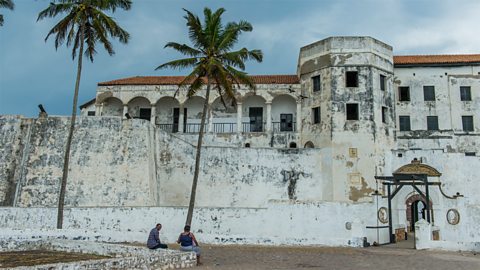
The Middle Passage
Many enslaved people had to wait months in dark cellars and dungeons of European-built castles and forts on the coast. Elmina Castle in modern-day Ghana, pictured here, and Bunce Island off the coast of modern-day Sierra Leone were used to imprison people before transportation to the Americas. Enslaved people were kept until ships had arrived to take them across the Atlantic. The gates of the castles and forts were known as points of no return. From here, enslaved people would be forced onto ships to endure the Middle Passage. The journey could take up to 12 weeks in horrific conditions.

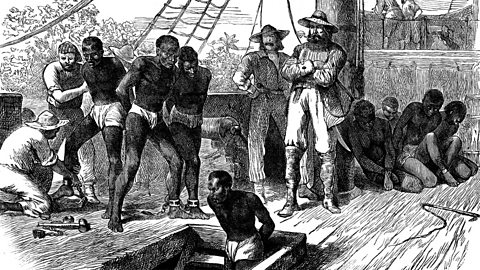
The journey to the Americas
Men were packed together below the decks in cramped conditions, chained to one another by the legs. From the writings of survivors, it is known that the air was putrid and hot, and that illness was rife. Women and children might be kept on the open upper decks, but were often subjected to abuse from the crew. Poor food, lack of sanitation and violent punishments given by the crew meant many died during the journey.

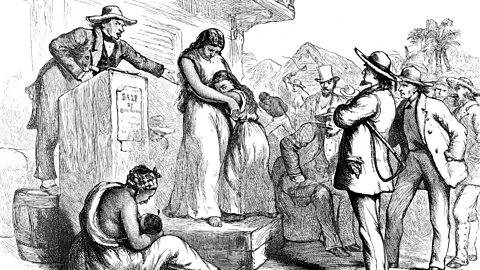
Arrival in the Americas
On arrival in the Americas, enslaved people were subjected to humiliating checks. They had their mouths opened to look at their teeth, and sometimes had oils put on their skin to make them look healthier after their difficult journey. Enslaved people were treated as objects and sold at auctions. They were sold to the highest bidder, and belonged to them for life. Following the auction, enslaved people were transported throughout the Americas. Two-thirds of enslaved people were sent to plantations in the Caribbean.

What is chattel slavery?
chattel slaveryAn enslaved person and their children who are owned by another and treated like property. is when enslaved people legally become the property of their owners, and any children born to the enslaved people are automatically enslaved too.
By 1625, the English had colonised the island of Barbados. They invaded the island of Jamaica in 1655, which had previously been captured by the Spanish, who had transported hundreds of enslaved West Africans to the island. After England defeated the Spanish, Jamaica, along with many other islands, became English colonies. Sugar crops were grown on these islands, using enslaved labour to work the land.
Initially most people that worked on the island of Barbados were āindentured servantsā. These were often poor people or prisoners from England and Europe who were forced into work for periods of around 5 to 7 years. They were often treated badly, however, unlike the enslaved population, after their period of work was finished they became free.
Over time, the enslaved population grew, and the government was concerned about rebellions. In 1661, the most powerful slave owners imposed the first slave codesLaws that governed an enslaved personsā life including life-long status as an enslaved person and strict punishments., called chattel slavery. It aimed to control and further dehumanisationTo remove from a person the special human qualities. For example independent thoughts or feelings. the enslaved people in the colonies. The code described the enslaved population as āan uncertain dangerous pride of people,ā and interactions between white and Black enslaved populations was strictly controlled. These codes became the basis of similar laws on the island of Jamaica, and were enforced across the colonies.
Who was Anthony Johnson and what does his story show about the development of slavery in the English colonies?
Anthony Johnson was born in Angola, in central Africa. In the 1620s, he was enslaved and taken to Virginia.
By 1625, it appears that Johnson was living as a servant and being paid. He married another former enslaved person called Mary. By 1650, they owned over 250 acres of land and were wealthy, free tobacco farmers. They had children and were respected members of Virginian society, so respected that when their farm burnt down, the community contributed to its rebuilding. However, laws that made an enslaved person enslaved for life had begun to develop from the 1660s onwards. After Johnsonās death in 1670, his land was seized from his family and given to his neighbours. The new laws meant that Mary Johnson and their children could not own land. This story is representative of the small community of free African people who lived in Virginia. By the late 1600s, this community would be shut out of society, as Virginia adopted similar codes to Barbados and Jamaica.
Who benefitted as a result of the slave trade?
The slave trade made many people very rich but ruined the lives of enslaved people. Millions of men, women and children were forcibly removed from their African communities which had a devastating social, political and economic effect, as these communities were without people who were needed to help their communities to thrive.
British enslavers profited from the buying and selling of enslaved Africans to work on plantations. It is estimated that British ships transported 3.4 million people from Africa, of whom 2.6 million survived the journey and were enslaved.
Plantation owners bought enslaved people to work on their land for free. This meant plantation owners were able to make huge profits from the goods that were produced. When they retired, many plantation owners moved to England. They used their wealth to obtain political power or invest in factories, funding the industrial revolution. George Hibbert, a British plantation owner and politician, was pro-slavery and fought against William Wilberforceās abolition campaign. He believed it would be costly to the British Empire.
Factory owners built their mills and factories using money made from the slave trade. The availability of cheap cotton produced from enslaved labour meant that Britainās textile industry grew significantly, contributing to Britainās industrial revolution. These factories provided many jobs for ordinary people, and though they may not have been directly involved, they too benefitted from the effects of the slave trade.
Many West African leaders were active participants in the slave trade, capturing people and selling them to Europeans. African slave sellers grew wealthy by selling captured people to European traders on the coast. During the 18th century, Asante, which covered most of present day Ghana, supplied gold and enslaved people to European traders. In exchange they received firearms, which allowed the kingdom to expand their territory.
British Empire overview activity
Learn more about some of the key events in the history of the British Empire with this activity.
Test your knowledge
Play the History Detectives game! gamePlay the History Detectives game!
Analyse and evaluate evidence to uncover some of historyās burning questions in this game.

More on Slavery
Find out more by working through a topic
- count6 of 7
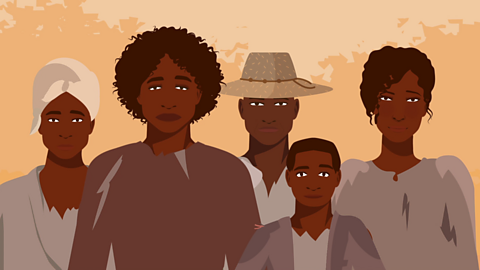
- count7 of 7
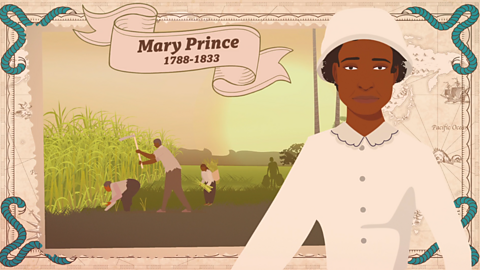
- count1 of 7
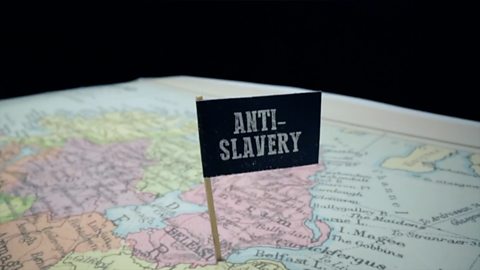
- count2 of 7
